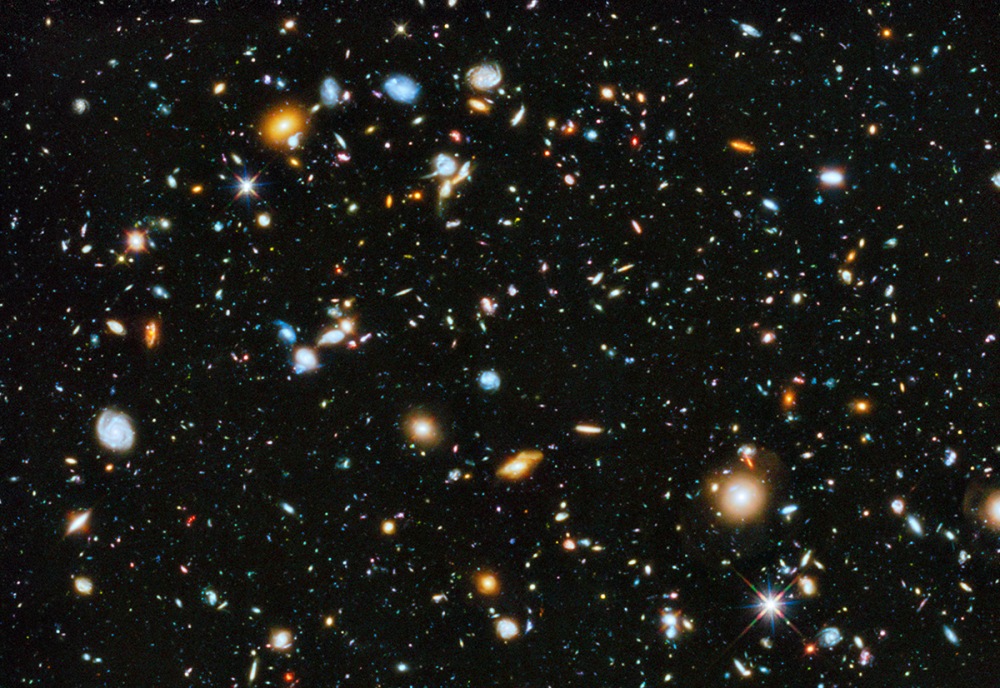June 24 Observatory Open House / Lecture /Public Star Night
“LIFESTYLES OF THE STARS”
The Estes Valley Astronomical Society (EVAS) in conjunction with The Estes Park Memorial Observatory is offering a free public open house/star night on Saturday, June 24th, 7 PM. The goal of EVAS is to promote amateur astronomy and education in the Estes valley.

Hubble Ultra Deep Field – credit NASA
Stars are like people. They may be conceived in a brief, energetic event. Then they go through a gestation period, followed by colicky infant stages, a relatively stable adolescence, midlife crises, and unstable old age. Also like people, stars can leave behind fossils that reveal their prior existence.
In the case of our Sun, it’s entering middle age as a roughly 5-billion-year-old hotshot who thinks it’s the center of a solar system. But midlife crises are looming. As its core nuclear reactor redistributes itself, the Sun will swell up to become a planet-consuming red giant, to be followed by a disruptive core blow-out involving as much power as all the stars in a galaxy. Fortunately, the Sun has Gravity-Care Insurance and will survive this episode, but it will eventually become unstable and gradually blow off its outer layers to produce a graffiti-art planetary nebula. (Unfortunately, this won’t actually involve planets…remember, the red giant consumed them.) What’s left afterward will be a white dwarf, a star in retirement. It will have little to do but hang around for billions of years, as an Earth-size fossil. Looking on the bright side, it may eventually resemble a giant diamond!
The vast majority of stars are less massive than the Sun, and they lead really boring lives, unworthy of even a bad reality show. These stars, called red dwarfs, just sit there in space, shining at a relatively constant rate for billions and billions of years.
The real excitement lies with stars significantly more massive than the Sun, which burn through their nuclear fuel quickly, lasting for millions rather than billions of years. These relatively rare stars make heavier and heavier elements, getting hotter and hotter in their interiors, until…BLAM…they explode as supernovae. In this astonishingly brief, energetic process, they trigger new star formation, make and distribute elements in our planet and our bodies, and leave behind incredible fossils…either Estes-Valley-size neutron stars or black holes. Black holes can be as large as a solar system or smaller than a pika. If you find one of these while looking around Estes Park for pika sculptures, it would be best to stay away from it.
This public talk, supplemented with visual aids, is intended for a general audience.
Our speaker is Dr. Gordon MacAlpine a retired astronomer, physicist and a member of the EVAS club. He received a BA in physics from Earlham College and a Ph.D. in astronomy from the University of Wisconsin. After a stint at the Institute for Advanced Study in Princeton, NJ, he joined the faculty at the University of Michigan where he was a Professor of Astronomy until 2000. Then he accepted the Zilker Distinguished Professor of Physics chair at Trinity University in San Antonio, TX, where he continued teaching astronomy, physics, and environmental science until his retirement in 2012. Gordon and his wife, Barbara, recently moved to Estes Park
The observatory is just north of the high school at 1600 Manford Ave. Park in the teacher’s parking lot adjacent to the observatory. The doors will open at 7:00pm and the meeting will start at 7:30pm. The presentation, including a question and answer period, lasts about an hour. After the presentation, weather permitting, we will look through the new 16 inch dome telescope at various celestial objects. Information about the meeting can be found on the observatory website at: www.AngelsAbove.Org
If you have any questions, please check the EPMO web site at: www.AngelsAbove.org . The lecture is free to the public and no reservations necessary. Just come and join the party and be ready to ask questions! For more information, please call the observatory at 970-586-5668
